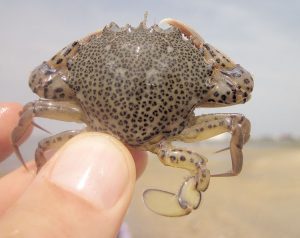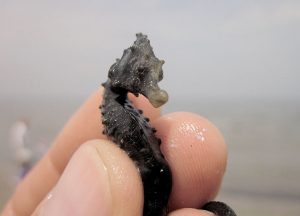‘Seine the Bay Day’ Reveals What Lies Beneath
Story and photos by Joe Reynolds
What’s swimming in Raritan Bay and Sandy Hook Bay? It turns out quite a bit.
Members of the all-volunteer Bayshore Regional Watershed Council conducted the sixth annual late spring “Seine the Bay Day” on June 4. The goal was to discover what fish, crabs and other aquatic creatures live along the edge of Raritan Bay and Sandy Hook Bay, the southern shore of New York Harbor.
Surveys were conducted at four locations: Cliffwood Beach in Aberdeen Township, Conaskonck Point in Union Beach, near the mouth of Pews Creek in Port Monmouth, and near the mouth of Many Mind Creek in Atlantic Highlands.
As in years past, a 50-foot-long seine net, a horizontal nylon net with buoys on top and weights on the bottom, was dragged through shallow waters and pulled towards the shore. All aquatic creatures were identified, cataloged, and returned to the estuary.

By seining the shore, watershed members were able to show how local waters are an important nursery. Many of the critters found included young-of-year (YOY) fish – juvenile fish that have hatched out of eggs this past spring. Schools of young herring were found in abundance at Cliffwood Beach, Port Monmouth, and Atlantic Highlands. The herring hatched out of eggs in freshwater portions of the estuary several weeks ago, and are now swimming towards saltier waters with the start of warm weather.
Over 20 juvenile winter flounder, a flatfish, were also found at Atlantic Highlands. They averaged in size between two to three inches long. Their high density near the mouth of Many Mind Creek suggests the sandy shoreline is a nursery. As populations of winter flounder continue to decline in the Northeast, it’s important to detect these areas.
Other signs of new life included pregnant silversides or spearing, and clusters of snail eggs at all four sites. Exposed Horseshoe crabs were also found in wet sand at Cliffwood Beach.

The most unique discovery of the day, however, was hauling in an adult seahorse at Port Monmouth. Yes, they really do exist in Sandy Hook Bay. The Northern lined seahorse is our native species. They often can be found clinging to sea grasses, pilings, or other floating objects in shallow waters foraging for tiny shellfish. Sadly, due to the loss of many sea grass beds, seahorse populations are lower around Sandy Hook Bay than in decades past.
In addition to seining, volunteers surveyed the water for salinity, turbidity, and water temperature. Salinity readings were about 23 parts per thousand and water temperature averaged in the low to mid 70s F. Turbidity tests showed the water to be quite murky, especially at Atlantic Highlands, where volunteers could not even see their toes in less than one foot of water.
No doubt, seining is a great way to gain an insight into the health of the near-shore environment where many people swim and enjoy the water. It provides a snap shot at what dwells along the edge of Sandy Hook Bay and Raritan Bay.
Joe Reynolds is co-chair of the Bayshore Regional Watershed Council (www.restoreraritanbay.org) and a local naturalist. See the website for a full list of fish found at each site.














